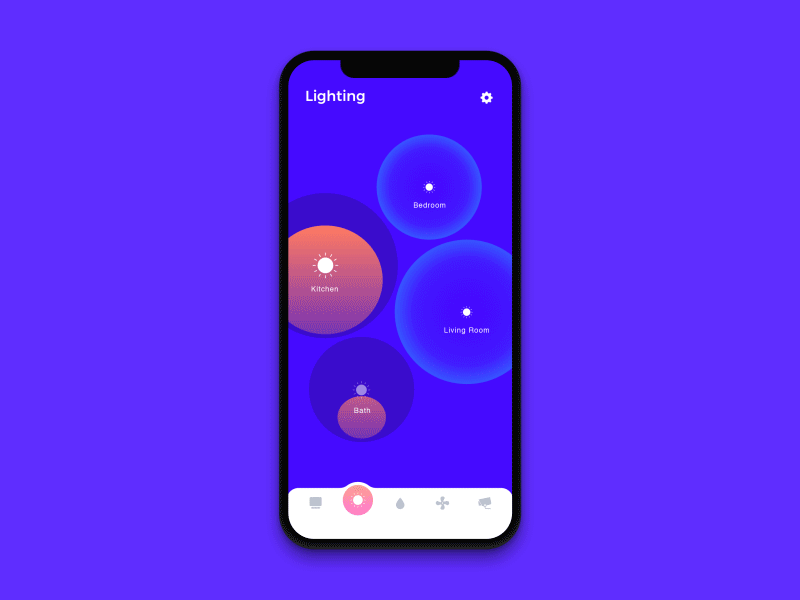Remember when Korben Dallas in The Fifth Element movie wakes up and so does his apartment. Music starts to play, lights turn on, the bed makes itself. We can say that 21 years later we still don’t have flying cars, but we control our houses with simple smart home apps. The future of smart home market looks attractive with emerging trends and increasing awareness of consumers in safety and security, personalized experience as well as the adoption of cloud-based technologies.
In this blog post, we answer 5 questions that will help you to improve and better understand your smart home idea.
Is your smart solution really smart?
Over the last years, there has been an increased interest in the smart home. Many world tech companies have announced that they are going to make the smart home their next big thing and invest in it. However, let’s sort out, what is smart and what is the difference between the smart and connected device?
For many years we have been using a variety of automated devices in our houses: home thermostats, remote light switches, and others. Recently, manufacturers have started to add web connectivity to these devices, which makes it possible for users to manage and monitor them from anywhere at any time using a smartphone. These devices are known as “connected”. However, some marketers mistakenly call them “smart” devices, which they are not. A real smart device contains a certain intelligence, which is located in the cloud. As an example take a smart leak detection system. In case it detects a leak, it automatically turns off the water and prevents any damages.
A smart solution is a solution behind the smart home idea. Yet, the use of an intelligent device in the home, which is labeled as a smart home product doesn’t make a home smart.
The crucial components of a smart home are integration and expansion. For example, some malfunctions in your kitchen sink have appeared. In this case, your smart home connects online to your plumber to make an appointment for a service day. Knowing your work schedule, it gives a one-time door access code that deactivates your security code and lets the plumber enter your house and fix the sink. At the same time, you can watch the plumber’s progress through your security camera.
Smart home apps should bring value, be convenient in use, and solve real problems that users face. Imagine that your smart home acts as your assistant who is able to prevent, reveal, and fix disruptions that happen to users during their everyday lives.
Is it equally smart and user-friendly?
There is a common problem that draws users away from purchasing a smart home app: the inconvenience. Smart devices are all about interfaces and easy integration into people's lives. Users want to have simple navigation and one best home automation app to control all devices. Assume that a person has a smart home equipped with several IoT devices: a thermostat to control temperature from a smartphone, smart lighting to remotely turn on and off the lights or a robot vacuum cleaner with remote control. For now, we have three different smart home apps, which a user has to manage. Because these apps are not integrated into one platform, it provides users with a headache instead of a comfort.
In a perfect world, it would be possible to control a house using a single app or interface. For example, with a voice assistant, a user can control everything without a need to type in the action. The examples of such devices are Alexa, Siri, Google Assistant. There are two options to access these voice assistants: either through a smartphone or if buying a special device that can handle all voice commands.
Another opportunity for a user to control everything using a single device is a smart home hub. A smart home allows integration between all smart home devices to perform various tasks and control of those devices in one interface. It is possible to set up the temperature and lights using the same app.
This certainly makes controlling various smart home devices much simpler and with the voice control, you won’t be hunting for your phone to turn on the lights.
Is your target market right?
The smart home market continues to grow. If previously smart home automation systems were considered as a luxury, today more households are considering to equip their houses with smart home devices. However, before developing the next product, it is worth approaching each country differently. According to a forecasting study conducted by Berg Insight, by 2020, 91 million homes in Europe and North America will be smart.
The home automation industry analysis shows that the USA is the best smart home market across the globe followed by Europe. It is expected that by 2021 there will be 73 million smart homes in North America, which equals 55 percent of all homes. Americans are ambassadors of a comfortable lifestyle. The most preferred products in smart homes are smart lighting, security systems, lighting, audio systems, and climate control.
European smart home market is not that big as in the USA. The key opportunities for the smart home market in Europe are energy and cost saving, security and convenience, and more. For example, Scandinavian countries drive the development of alternative sources of energy and for them, the smart home is a way to save natural resources. Southern European countries have lower standards of living, thus people there are less interested in the adoption of smart home automation systems. Those who live in Portugal or Spain save as much as possible on heating.
The United Arab Emirates is the leading country in the adoption of home automation solutions. Because of the constant heat, the country residents and tourists spend most of the time in air-conditioned premises. For this reason, climate control devices are the most popular in UAE. UAE is also known as one of the safest countries in the world. Many people don't even lock their cars. Taking into consideration this fact, smart home security systems are less popular. But due to high utility bills, residents of UAE concentrate on saving.
Due to the increasing adoption of cloud-based technologies, increasing population and standard of living, the Asia Pacific region is expected to have the highest adoption of smart home applications. It is expected that the Asia Pacific smart home market will reach US$115 billion by 2030, which will account for 30 percent of the global share.
Can your application ensure security?
More IoT devices increase the chances of hacking. Consequently, it is essential for both developers and users to take care of safety and privacy vulnerabilities. So what are the ways to keep smart home security and avoid being hacked?
-
Using two-factor authentication can save you from a phishing attack. When you log in from another device or location, you are required to enter an additional password that might be sent by SMS or automatically generated by your phone. In this case, even if the hackers get your password, they won’t be able to log in.
-
Complete security updates. Neglecting software updates can cause dangerous malware. Most smart home devices don’t update automatically that’s why once a month users should check their smart home appliances for firmware updates.
-
Don’t use public Wi-Fi. When accessing your smart home remotely, avoid using public Wi-Fi networks. Hackers can use them to get access to your home.
Providing that developers and consumers adhere to the highest level of mobile security on all devices, home automation solutions can bring many benefits to our lives.
Have you paid enough attention to a mobile application?
Wearables and smart home devices eliminate the need for computer screens and keyboards, which brings new ways for users to interact with devices in more unexpected ways.
We have reached the point when we can totally control our house: temperature, lights, security, air pollution, etc. Modern IoT smart home apps take care of users’ comfort and safety.
Wearables and smart home devices eliminate the need for computer screens and keyboards, which brings new ways for users to interact with devices in more unexpected ways.
The graph below shows that the market for the smart home is growing. It is clear why many companies invest in smart home application development. But to succeed in this market, it’s worth paying attention to the app’s usability, design, and set of features.

Source: Statista
Design
While some IoT devices user can control via mobile apps, others require the use of voice interactions. As IoT development becomes a bigger part of our lives, we may expect a rise in new user experience design. Design of internet of things app should be user-friendly, provide value and positively impact the user’s day-to-day routine. If designers use best practices and create technology that will connect the creativity with true usefulness, then IoT devices will successfully position themselves.
It’s not that simple to design a user experience for IoT products. IoT systems consist of several devices, a number of interfaces and apps with various functionality, and user rights distribution. It is not enough to build a set of cross-device user flows for an IoT product. It is more important to create a user experience that will help people to manage IoT product with ease.
Most connected IoT devices are mobile. Design for smaller screens should be responsive, which means in response to the user’s behavior and environment based on the UI’s size.

Smart Home App Concept by Agilie Team
Making your app accessible
This is the most basic and important feature in the mobile monitoring system for the smart home
for a smart home. Just using a special smart home monitoring app, the user can control home appliances like doors and lamps with a touch of a fingerprint. The user is able to control his house from anywhere at any time.
Accessing user configuration
The homeowner should have admin rights, which requires setting up an access configuration. In this case, home automation would have the correct access and avoid mistakes.
Sending push notifications
Notifications show users the status of all the integrated devices in the house. If a person forgets to turn off the lights, close the garage or doors, the system sends instant notifications.
Summary
Soon owning a smart home device may not be a matter of a choice but rather a necessity. Shortly when buying a light switch consumers won’t have another option but to buy a smart light switch.
If you are considering to enter IoT market and start home automation business but still wonder how to implement all of your smart home business ideas, get in touch with our experts who will give you a technology consultancy and project estimation. We also invite you to read our latest case study on smart home safety and mobile security software.